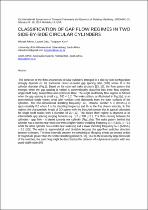JavaScript is disabled for your browser. Some features of this site may not work without it.
- ResearchSpace
- →
- Research Publications/Outputs
- →
- Conference Publications
- →
- View Item
| dc.contributor.author |
Atkins, M

|
|
| dc.contributor.author |
Dala, L

|
|
| dc.contributor.author |
Tongbeum Kim, T

|
|
| dc.date.accessioned | 2014-09-30T13:13:03Z | |
| dc.date.available | 2014-09-30T13:13:03Z | |
| dc.date.issued | 2014-02 | |
| dc.identifier.citation | Atkins, M, Dala, L and Tongbeum Kim, T. 2014. Classification of gap flow regimes in two side-by-side circular cylinders. In: 15th International Symposium on Transport Phenomena and Dynamics of Rotating Machinery, ISROMAC-15, Honolulu, HI, USA, 24-28 February 2014 | en_US |
| dc.identifier.uri | http://hdl.handle.net/10204/7691 | |
| dc.description | 15th International Symposium on Transport Phenomena and Dynamics of Rotating Machinery, ISROMAC-15, Honolulu, HI, USA, 24-28 February 2014. Abstract attached. | en_US |
| dc.description.abstract | The behavior of the flow around two circular cylinders arranged in a side-by-side configuration strongly depends on the transverse center-to-center gap spacing ratio (T/D) where D is the cylinder diameter. Based on the observed wake structure [13, 15], the flow pattern that emerges when the gap spacing is varied is conventionally classified into three flow regimes: single bluff body, biased flow and symmetric flow. The single bluff body flow regime is defined when the gap spacing is small e.g., T/D < 1.2. The wake pattern is an asymmetrical single vortex street with vortices shed alternately from the outer surfaces of the cylinders. The non-dimensional shedding frequency, i.e., Strouhal number S = (f2D/U8) is approximately 0.2 where f is the shedding frequency and U8 is the free stream velocity. In this regime, the characteristic length of 2D agrees with the Strouhal number that is typical calculated for single bluff bodies with a diameter of 2D [12]. The biased flow regime is observed at an intermediate gap spacing ranging between e.g., 1.2 = T/D = 2.2. The flow passing between the cylinders - gap flow - is biased towards one cylinder (Fig.1.(b)). The wake pattern behind that cylinder has a narrow near-wake (n) with a higher vortex shedding frequency Sn = (fnD/U8) ~ 0.3 while the other cylinder has a wider near-wake (w) and a lower shedding frequency Sw = (fwD/U8) ~ 0.1 [15]. The wake is asymmetrical and bi-stable because the gap-flow switches direction between cylinders. The time intervals between the switching or flopping events are several orders of magnitude greater than the vortex shedding period [9, 16]. Due to the relatively large timescale of the switches, the switching might be described as the behavior of a dynamical system with two quasi-stable states (9). | en_US |
| dc.language.iso | en | en_US |
| dc.relation.ispartofseries | Workflow;12621 | |
| dc.subject | Gap flow regimes | en_US |
| dc.subject | Rotating Machinery | en_US |
| dc.subject | Stream velocity | en_US |
| dc.subject | Side-by-side circular cylinders | en_US |
| dc.title | Classification of gap flow regimes in two side-by-side circular cylinders | en_US |
| dc.type | Conference Presentation | en_US |
| dc.identifier.apacitation | Atkins, M., Dala, L., & Tongbeum Kim, T. (2014). Classification of gap flow regimes in two side-by-side circular cylinders. http://hdl.handle.net/10204/7691 | en_ZA |
| dc.identifier.chicagocitation | Atkins, M, L Dala, and T Tongbeum Kim. "Classification of gap flow regimes in two side-by-side circular cylinders." (2014): http://hdl.handle.net/10204/7691 | en_ZA |
| dc.identifier.vancouvercitation | Atkins M, Dala L, Tongbeum Kim T, Classification of gap flow regimes in two side-by-side circular cylinders; 2014. http://hdl.handle.net/10204/7691 . | en_ZA |
| dc.identifier.ris | TY - Conference Presentation AU - Atkins, M AU - Dala, L AU - Tongbeum Kim, T AB - The behavior of the flow around two circular cylinders arranged in a side-by-side configuration strongly depends on the transverse center-to-center gap spacing ratio (T/D) where D is the cylinder diameter. Based on the observed wake structure [13, 15], the flow pattern that emerges when the gap spacing is varied is conventionally classified into three flow regimes: single bluff body, biased flow and symmetric flow. The single bluff body flow regime is defined when the gap spacing is small e.g., T/D < 1.2. The wake pattern is an asymmetrical single vortex street with vortices shed alternately from the outer surfaces of the cylinders. The non-dimensional shedding frequency, i.e., Strouhal number S = (f2D/U8) is approximately 0.2 where f is the shedding frequency and U8 is the free stream velocity. In this regime, the characteristic length of 2D agrees with the Strouhal number that is typical calculated for single bluff bodies with a diameter of 2D [12]. The biased flow regime is observed at an intermediate gap spacing ranging between e.g., 1.2 = T/D = 2.2. The flow passing between the cylinders - gap flow - is biased towards one cylinder (Fig.1.(b)). The wake pattern behind that cylinder has a narrow near-wake (n) with a higher vortex shedding frequency Sn = (fnD/U8) ~ 0.3 while the other cylinder has a wider near-wake (w) and a lower shedding frequency Sw = (fwD/U8) ~ 0.1 [15]. The wake is asymmetrical and bi-stable because the gap-flow switches direction between cylinders. The time intervals between the switching or flopping events are several orders of magnitude greater than the vortex shedding period [9, 16]. Due to the relatively large timescale of the switches, the switching might be described as the behavior of a dynamical system with two quasi-stable states (9). DA - 2014-02 DB - ResearchSpace DP - CSIR KW - Gap flow regimes KW - Rotating Machinery KW - Stream velocity KW - Side-by-side circular cylinders LK - https://researchspace.csir.co.za PY - 2014 T1 - Classification of gap flow regimes in two side-by-side circular cylinders TI - Classification of gap flow regimes in two side-by-side circular cylinders UR - http://hdl.handle.net/10204/7691 ER - | en_ZA |






